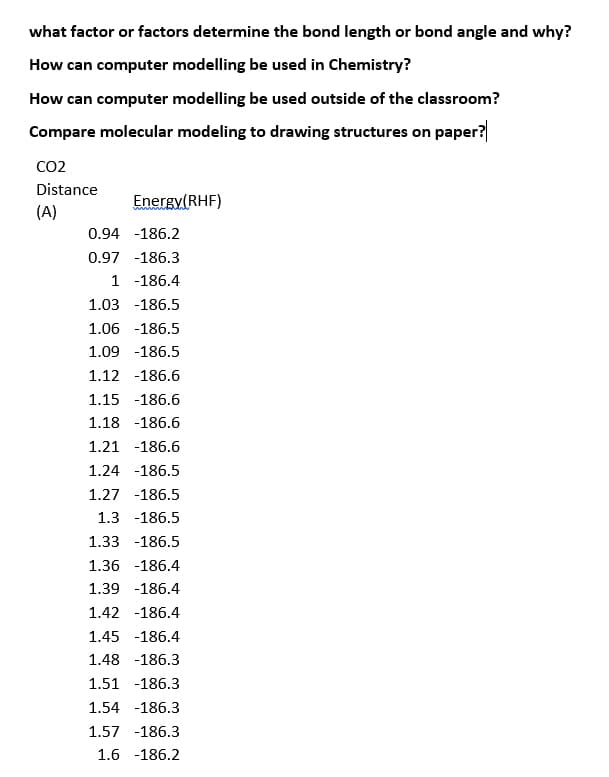what factor or factors determine the bond length or bond angle and why? How can computer modelling be used in Chemistry? How can computer modelling be used outside of the classroom? Compare molecular modeling to drawing structures on paper? CO2 Distance Energy(RHF) (A) 0.94 -186.2 0.97 -186.3 1 -186.4 1.03 -186.5 1.06 -186.5 1.09 -186.5 1.12 -186.6 1.15 -186.6 1.18 -186.6 1.21 -186.6 1.24 -186.5 1.27 -186.5 1.3 -186.5 1.33 -186.5 1.36 -186.4 1.39 -186.4 1.42 -186.4 1.45 -186.4 1.48 -186.3 1.51 -186.3 1.54 -186.3 1.57 -186.3 1.6 -186.2
what factor or factors determine the bond length or bond angle and why? How can computer modelling be used in Chemistry? How can computer modelling be used outside of the classroom? Compare molecular modeling to drawing structures on paper? CO2 Distance Energy(RHF) (A) 0.94 -186.2 0.97 -186.3 1 -186.4 1.03 -186.5 1.06 -186.5 1.09 -186.5 1.12 -186.6 1.15 -186.6 1.18 -186.6 1.21 -186.6 1.24 -186.5 1.27 -186.5 1.3 -186.5 1.33 -186.5 1.36 -186.4 1.39 -186.4 1.42 -186.4 1.45 -186.4 1.48 -186.3 1.51 -186.3 1.54 -186.3 1.57 -186.3 1.6 -186.2
General Chemistry - Standalone book (MindTap Course List)
11th Edition
ISBN:9781305580343
Author:Steven D. Gammon, Ebbing, Darrell Ebbing, Steven D., Darrell; Gammon, Darrell Ebbing; Steven D. Gammon, Darrell D.; Gammon, Ebbing; Steven D. Gammon; Darrell
Publisher:Steven D. Gammon, Ebbing, Darrell Ebbing, Steven D., Darrell; Gammon, Darrell Ebbing; Steven D. Gammon, Darrell D.; Gammon, Ebbing; Steven D. Gammon; Darrell
Chapter10: Molecular Geometry And Chemical Bonding Theory
Section: Chapter Questions
Problem 10.23QP
Related questions
Question
100%
I wanna help to answer this questions
Thanks a lot

Transcribed Image Text:what factor or factors determine the bond length or bond angle and why?
How can computer modelling be used in Chemistry?
How can computer modelling be used outside of the classroom?
Compare molecular modeling to drawing structures on paper?
CO2
Distance
Energy(RHF)
(A)
0.94 -186.2
0.97 -186.3
1 -186.4
1.03 -186.5
1.06 -186.5
1.09 -186.5
1.12 -186.6
1.15 -186.6
1.18 -186.6
1.21 -186.6
1.24 -186.5
1.27 -186.5
1.3 -186.5
1.33 -186.5
1.36 -186.4
1.39 -186.4
1.42 -186.4
1.45 -186.4
1.48 -186.3
1.51 -186.3
1.54 -186.3
1.57 -186.3
1.6 -186.2
Expert Solution
This question has been solved!
Explore an expertly crafted, step-by-step solution for a thorough understanding of key concepts.
This is a popular solution!
Trending now
This is a popular solution!
Step by step
Solved in 3 steps

Knowledge Booster
Learn more about
Need a deep-dive on the concept behind this application? Look no further. Learn more about this topic, chemistry and related others by exploring similar questions and additional content below.Recommended textbooks for you

General Chemistry - Standalone book (MindTap Cour…
Chemistry
ISBN:
9781305580343
Author:
Steven D. Gammon, Ebbing, Darrell Ebbing, Steven D., Darrell; Gammon, Darrell Ebbing; Steven D. Gammon, Darrell D.; Gammon, Ebbing; Steven D. Gammon; Darrell
Publisher:
Cengage Learning

Chemistry: Principles and Practice
Chemistry
ISBN:
9780534420123
Author:
Daniel L. Reger, Scott R. Goode, David W. Ball, Edward Mercer
Publisher:
Cengage Learning

Chemistry: The Molecular Science
Chemistry
ISBN:
9781285199047
Author:
John W. Moore, Conrad L. Stanitski
Publisher:
Cengage Learning

General Chemistry - Standalone book (MindTap Cour…
Chemistry
ISBN:
9781305580343
Author:
Steven D. Gammon, Ebbing, Darrell Ebbing, Steven D., Darrell; Gammon, Darrell Ebbing; Steven D. Gammon, Darrell D.; Gammon, Ebbing; Steven D. Gammon; Darrell
Publisher:
Cengage Learning

Chemistry: Principles and Practice
Chemistry
ISBN:
9780534420123
Author:
Daniel L. Reger, Scott R. Goode, David W. Ball, Edward Mercer
Publisher:
Cengage Learning

Chemistry: The Molecular Science
Chemistry
ISBN:
9781285199047
Author:
John W. Moore, Conrad L. Stanitski
Publisher:
Cengage Learning

Chemistry: An Atoms First Approach
Chemistry
ISBN:
9781305079243
Author:
Steven S. Zumdahl, Susan A. Zumdahl
Publisher:
Cengage Learning


Chemistry
Chemistry
ISBN:
9781305957404
Author:
Steven S. Zumdahl, Susan A. Zumdahl, Donald J. DeCoste
Publisher:
Cengage Learning